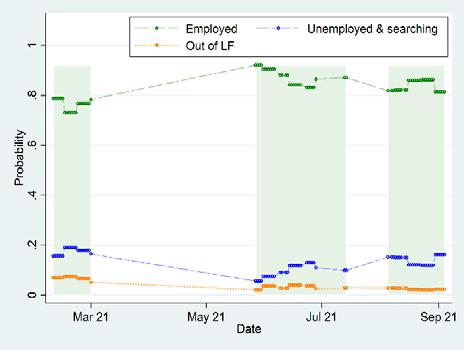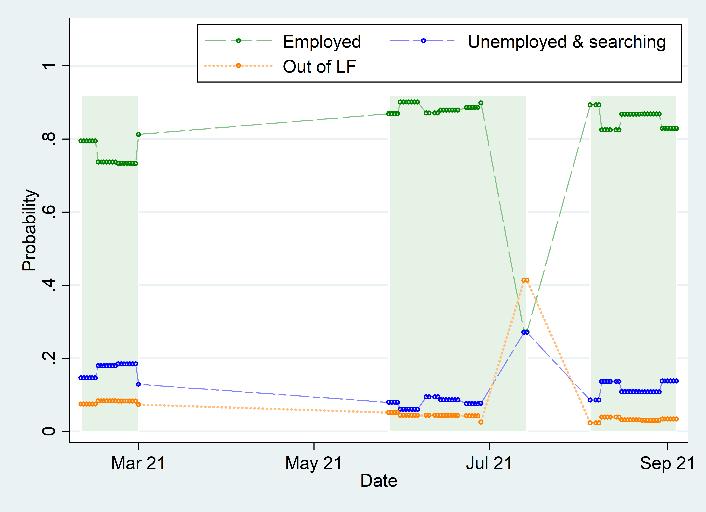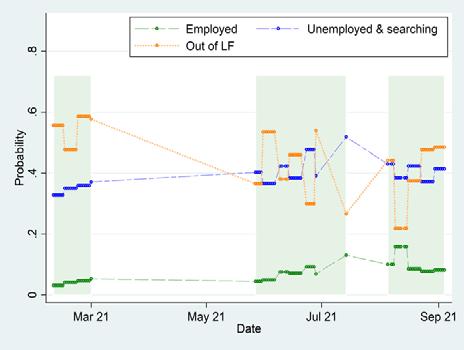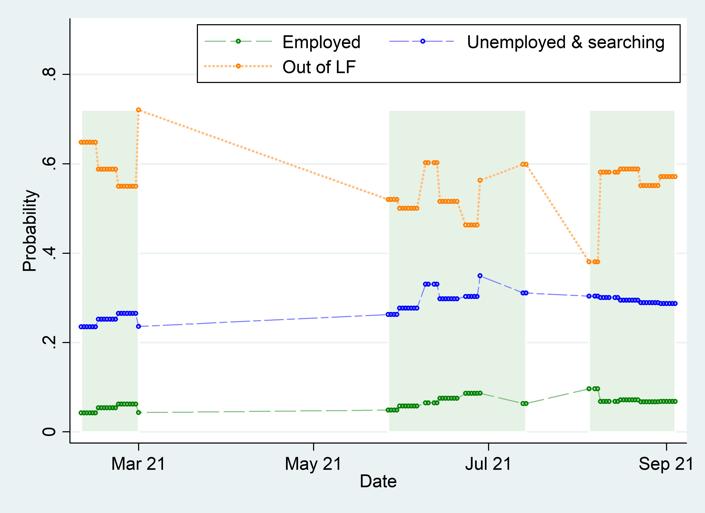
3 minute read
Model robustness tests
low probability of landing jobs. This probability peaked in July or August, and has abated since. Interestingly among Jordanian women, youths are significantly more likely to search for jobs if they are notemployed, and thus less likely to remain OLF.
Figure 7. Predicted probability of main job/activity by survey wave, Jordan, by age-group and sex
i. Male youths i. Male non-youths

iii. Female youths iv. Female non-youths


Source: Authors’ calculations based on ERF COVID-19 Household Monitors, waves 1–5.
Model robustness tests
The dynamic multinomial logistic model applied here has many theoretical and empirical merits, but some limitations and potential pitfalls should be acknowledged. This section discusses the potential issues and, where available, reports the results of tests and alternative estimations.
Most saliently, while the majority of explanatory variables in multinomial logit regressions are significant when evaluated jointly across the columns, meaning that the variables belong in the model, many of the AMEs in individual columns are insignificant individually, meaning that the corresponding variables may have positive or negative effects on particular employment outcomes. There are several explanations for the weak results. One, the inclusion of both youths and non-youths –and other groupings across demographic divides, such as workers with dependents and those without – in the same models confounds the differential impacts on prime-age workers (as child-carers and caretakers) and recent graduates (as, say, loosely attached workers or marriage-market aspirants). The main specifications in tables 1–2 were thus supplemented by models disaggregated along important demographic lines. The regressions were run separately for youth and non-youth, as well as for those starting in formal, informal, or inactive employment statuses (Tansel and Ozdemir 2019). Interaction terms of education/experience with the demographic indicator (e.g., youth) were also evaluated. These supplementary models produced similar results, broadly validating the main specifications.
Two, the lack of controls for panel dynamics, such as worker fixed effects, introduces small possible biases due to sample selection and attrition. While we have considered individual-level fixed-effect specifications, their viability is affected by the limited time dimension of data. Three, the joint use of youth status, time trends, and sluggishly evolving COVID-19 stringency in regressions leads to some collinearity among covariates, which affects the reliability and efficiency of relevant coefficients. Alternative sets of covariates and sample compositions were considered, as follows: The counts of children under 6 years, and school-age children, either separately or jointly; linear and quadratic potential experience (age–16.5 for youths, age–29 for non-youths –denoted as age–min[age]); marital status; log household size.
Regarding structural properties, the dynamic models in tables 1–2 have several potential limitations. One, they exclude wave 0 from the analysis, and their estimates (as in ‘x×y covariances’) are thus based on lower sample sizes. Two, the lagged dependent variables among regressors assume great explanatory power at the expense of other time-invariant or slow-motion underlying factors such as education, which may be causally more responsible for employment outcomes. An alternative static specification without lagged dependent variables, using February 2020 as an additional survey wave, has been estimated and the results are available on request.
Three, a critical assumption for the validity of the multinomial logistic model is independence of irrelevant alternatives (IIA) – the ratio of the probabilities of any two statuses should be independent of the set of possible options. Clear violations of this assumption can be identified using the Hausman tests (Hausman and McFadden 1984). In our case, these tests fail to reject the IIA assumption in all country sex-group regressions, implying that the estimates are not clearly systematically affected by the exclusion of any one of the outcomes from the analysis. For completeness, the selected logit regressions outperform or perform as well as equivalent probit specifications in terms of R-squared and other measures of fit.
Given the different availability of employment statuses across survey waves, supplementary regressions also considered alternative sets of dependent variables, namely: 1) public/private sector of employment; 2) informal/irregular/self/unpaid with or without regard for whether in/out of establishment; 3) COVID-induced status changes beside the permanent/temporarily job loss – hours change and pay change. Individual-level fixed effects were considered to mitigate any biases and heteroskedasticity in estimation due to latent heterogeneity across workers.




